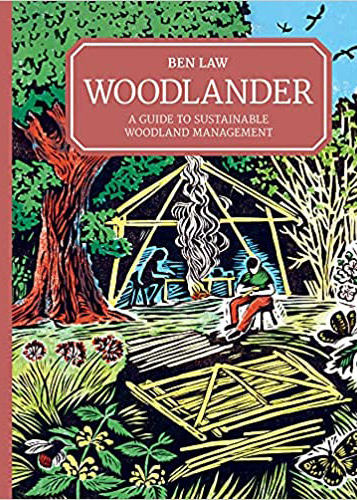From Living Woods issue 61
Woodland manager and forestry lecturer MIKE JONES enjoys
Ben Law’s latest book of practical advice

WOODLANDER
A Guide to Sustainable Woodland Management
BEN LAW
GMC Publications
Hardback
184 pages
RRP £25
ISBN 9781784945572
Previous books by Ben Law have focused on making things out of woodland produce, famously including his own house, and on the traditional tools needed for working with timber. His latest book, Woodlander, takes a step back and, in nine chapters, looks at the sustainable management of woodland, from establishment to harvesting and everything in between.
The book starts with a clear introduction to the types of woodland found in Britain today, from ancient enclosed woodland and wood pasture, to recent plantations and orchards. This is followed by practical advice on how to survey and assess a woodland site, including up-to-date information on tree diseases and an overview of the legal aspects of woodland ownership. The following three chapters cover the establishment, protection and management of woodland, including discussion of planting versus natural regeneration, native species versus non-native, and managing for biodiversity. Two chapters on the sale of timber and adding value to woodland through the sale of non-timber forest products are a valuable reminder of potential for income from woodlands. The importance of woodland for education, recreation and social benefit is covered next, and the book concludes with a very timely guide to buying woodland.
Clearly written, and drawing on Ben’s 30 years of experience, this book is far more than an aspirational coffee table book, and is a practical guide to sustainable woodland management. Although primarily aimed at new woodland owners, of whom there are many, it should also act as a prompt to more established owners and an encouragement to more active management.
One of the strengths of the book is the inclusion of mini case studies, mainly drawn from Ben’s own Prickly Nut Wood. The focus of the book is very much on lowland broadleaved woodland, including PAWS sites – conifer plantations don’t get much of a mention, despite making up a large proportion of the country’s tree stock. Given the likely readership, this is probably justified, however. The overall message, that good sustainable woodland management can benefit wildlife, the environment and society, whilst producing an income, is well made and a constant theme throughout. The types of woodland covered by this book are too often written off as amenity woodlands, non-intervention conservation areas or merely part of the landscape, but Ben clearly shows how they can, and should be so much more than this.
It is to be hoped that the new breed of woodland owner, often with a few acres within a larger block of woodland, will read this book and heed his message and that we see previously under-managed woodlands being brought back into active management.
The book is beautifully illustrated, both with clear photographs, each one carefully chosen to illustrate some point in the text, and with illustrator Jane Bottomley’s timeless pen and ink drawings.